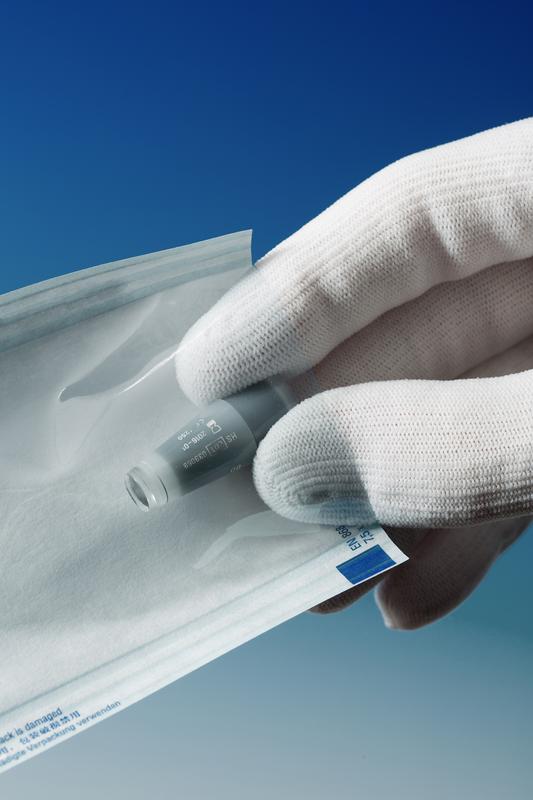Hygiene at your fingertips with the new CleanHand Network

Electron-beam sterilized packaging in the medical field © Fraunhofer FEP
Test reports and studies on the cleanliness of European motorway rest areas, hotel beds, and outdoor pools increasingly appear in the press, especially during peak travel periods. In addition, there are regular reports on the spread of germs in hospitals, kindergartens, and nursing homes.
The transmission and spread of infectious diseases and germs takes place in the majority of cases via ubiquitous door handles and washroom fixtures that cannot be avoided in daily life. But smartphones have also been tested for contamination and turned out to be a perfect habitat for bacteria, with an average of 3895 bacteria per square centimeter. Only dishcloths were found to have more bacteria.
In most cases, the main transmission path of bacteria and germs is obviously by manual contact. To interrupt the transmission paths, common items such as door handles and handrails must be given careful consideration. They should be made of materials or have surfaces that repel dirt, are easy to clean and disinfect, and do not provide conditions that promote harboring dirt, bacteria, and germs. The solutions for this are diverse, starting with antibacterial surfaces up to specialized surface modification and practical disinfection methods.
The topic of sterile surfaces and its many aspects therefore continues to be of current interest. Fraunhofer FEP has been involved in the development of processes and systems for cleaning, sterilization, and surface modification for decades.
In the course of many projects, the scientists and partners have identified an increasing need for networking in this area. In order to make better use of synergies and to advance joint projects for disinfecting everyday objects as well as application-oriented R&D in a focused manner, the decision was made to establish a network.
The CleanHand Innovation Network was therefore established in May 2018 as a consortium to develop systems and technologies for clean surfaces, materials, and objects. The Network is funded by the German Federal Ministry for Economic Affairs and Energy (BMWi, promotional reference 16KN082101). Initial projects focus on the development of disinfection technologies and procedures for door handles in public buildings, handholds in public transport, and the disinfection of touchscreens, such as in airports, railway stations, and elsewhere.
One of the members is the Fraunhofer FEP with expertise in R&D for the application of electrons in disinfection and sterilization applications, along with many years of accumulated know-how in antimicrobial coatings and easy-to-clean layers. The Institute's own biomedical laboratory with a wide range of tests including antibacterial efficacy, supports these research priorities.
Dr. Jessy Schönfelder, deputy head of Medical and Biotechnological Applications at Fraunhofer FEP, summarizes: “With our experience in the use of low-energy electrons for disinfection and sterilization of surfaces, the use of silver and copper for antibacterial coatings, as well as in the development of hydrophilic surfaces and photocatalytic layers, we can apply many different technologies. When developing specific applications, we can rely on these technologies in order to find innovative and practical solutions with our partners in the Network“.
In addition to the initial project for disinfecting various contact points in public areas, further ideas and projects are to be developed by members of the Network together with new partners in the field of hand hygiene.
The CleanHand Network intends to address partners and future customers that have problems related to hand hygiene and associated topics from the fields of medical engineering, the environment, health, and the life sciences in order to jointly develop solutions for practical applications, such as self-disinfecting fixtures for hospitals and areas requiring intensive cleaning.
During the parts2clean 2018 trade fair October 23-25 in Stuttgart, we offer the opportunity to learn about the Network at the Fraunhofer FEP booth.
Fraunhofer FEP at parts2clean 2018:
Hall 5, Booth C31 (Fraunhofer joint booth)
Special Exhibition: Part Cleaning 4.0 in Practice: Hall 5, Booth A18
The Network CleanHand is funded by the German Federal Ministry for Economic Affairs and Energy. Funding reference: 16KN082101
Network research partners:
Augst Kunststoff-Produkte GmbH
BRAND Werkzeug- und Maschinenbau GmbH
car systems Scheil GmbH & Co. KG
CGC Instruments
DeSonic GmbH
ECTC Steuerungstechnik GmbH
Fraunhofer FEP
Gesellschaft zur Förderung von Medizin-, Bio- und Umwelttechnologien e.V. (society for
the promotion of medical, bio- and environmental technologies)
MicroCeram GmbH
MoveoMed GmbH
SF Automationselektronik GmbH
Schliess- und Sicherungssysteme GmbH
RAS AG
Jena University Hospital
Press contact:
Ms. Annett Arnold
Fraunhofer Institute for Organic Electronics, Electron Beam and Plasma Technology FEP
Phone +49 351 2586 333 | presse@fep.fraunhofer.de
Winterbergstraße 28 | 01277 Dresden | Germany | www.fep.fraunhofer.de
Media Contact
All latest news from the category: Life Sciences and Chemistry
Articles and reports from the Life Sciences and chemistry area deal with applied and basic research into modern biology, chemistry and human medicine.
Valuable information can be found on a range of life sciences fields including bacteriology, biochemistry, bionics, bioinformatics, biophysics, biotechnology, genetics, geobotany, human biology, marine biology, microbiology, molecular biology, cellular biology, zoology, bioinorganic chemistry, microchemistry and environmental chemistry.
Newest articles

Bringing bio-inspired robots to life
Nebraska researcher Eric Markvicka gets NSF CAREER Award to pursue manufacture of novel materials for soft robotics and stretchable electronics. Engineers are increasingly eager to develop robots that mimic the…

Bella moths use poison to attract mates
Scientists are closer to finding out how. Pyrrolizidine alkaloids are as bitter and toxic as they are hard to pronounce. They’re produced by several different types of plants and are…

AI tool creates ‘synthetic’ images of cells
…for enhanced microscopy analysis. Observing individual cells through microscopes can reveal a range of important cell biological phenomena that frequently play a role in human diseases, but the process of…





















